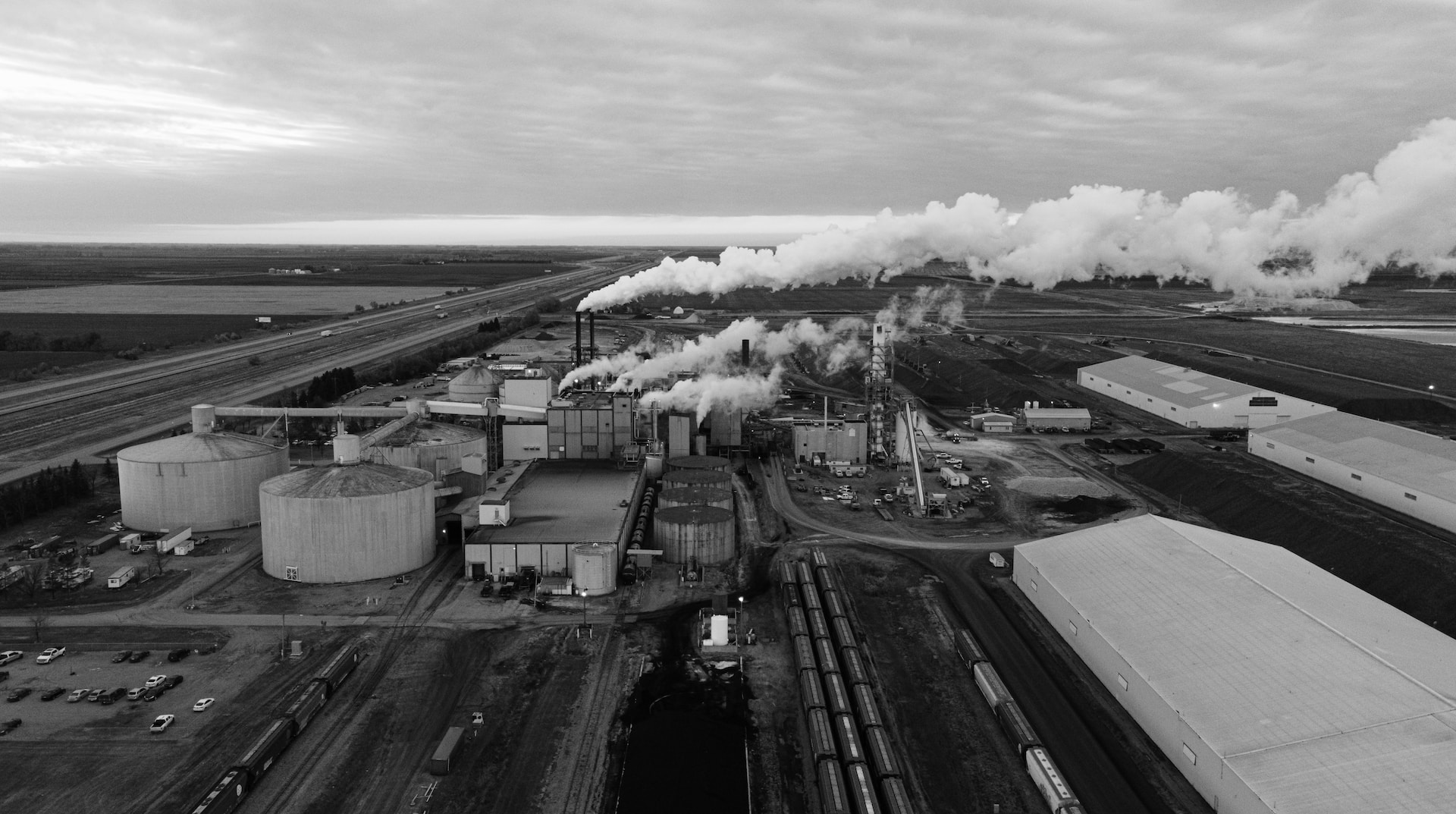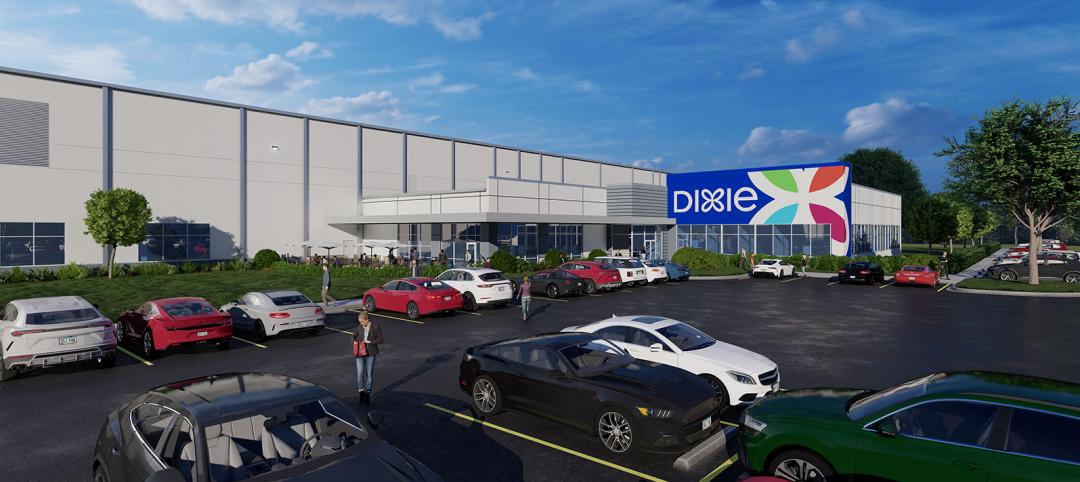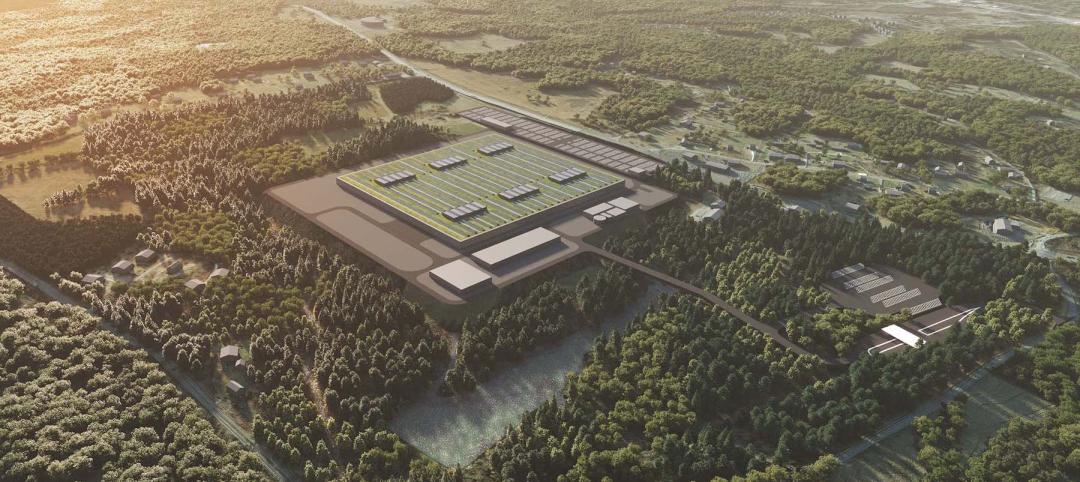The embodied carbon (EC) intensity in core and shell industrial buildings in the U.S. averages 23.0 kilograms per sf, according to a recent analysis of 26 whole building life-cycle assessments. That means a 300,000-sf warehouse would emit 6,890 megatons of carbon over its lifespan, or the equivalent of the carbon emitted by 1,530 gas-powered cars driven for one year.
Those sobering estimates come from a new benchmark study, “Embodied Carbon U.S. Industrial Real Estate,” which advocates for the measuring and reducing of EC in core and shell industrial buildings, one of the more vibrant commercial construction sectors.
The report was produced by BranchPattern, a Kansas City-based building consultancy dedicated to creating a better built environment. BranchPattern’s study partners for this report include Prologis, Brookfield Properties, IDI Logistics, Bridge Industrial, and Affinius Capital.

“We are at a pivotal moment for owners and developers of real estate to look beyond the greenhouse gasses emitted during building operations,” says Chris Brown, IDI Logistics’ Solar Development and ESG Director. “Working with industry peers, key partners, and suppliers to create pathways to lower carbon materials, design and construction techniques is an integral part of reducing the impact of buildings have in climate change.”
Building operations and building construction account for 28% and 11%, respectively, of global greenhouse gas emissions, according to the International Energy Agency. As buildings have become more energy efficient, operational carbon has been reduced. Therefore, addressing EC emissions “will become increasingly critical to meet climate goals,” states BranchPattern’s report, especially given that the global building area for industrial typologies is projected to double by 2050.
Right now, most of the available EC data are derived from lifecycle assessments of multifamily and office buildings. But based on conservative assumptions, EC is projected to account for 17.4% of a typical industrial building’s total emissions over 60 years. The report calls for greater access to EC measurement tools and comparative data that can help the industrial sector making informed design and construction decisions.
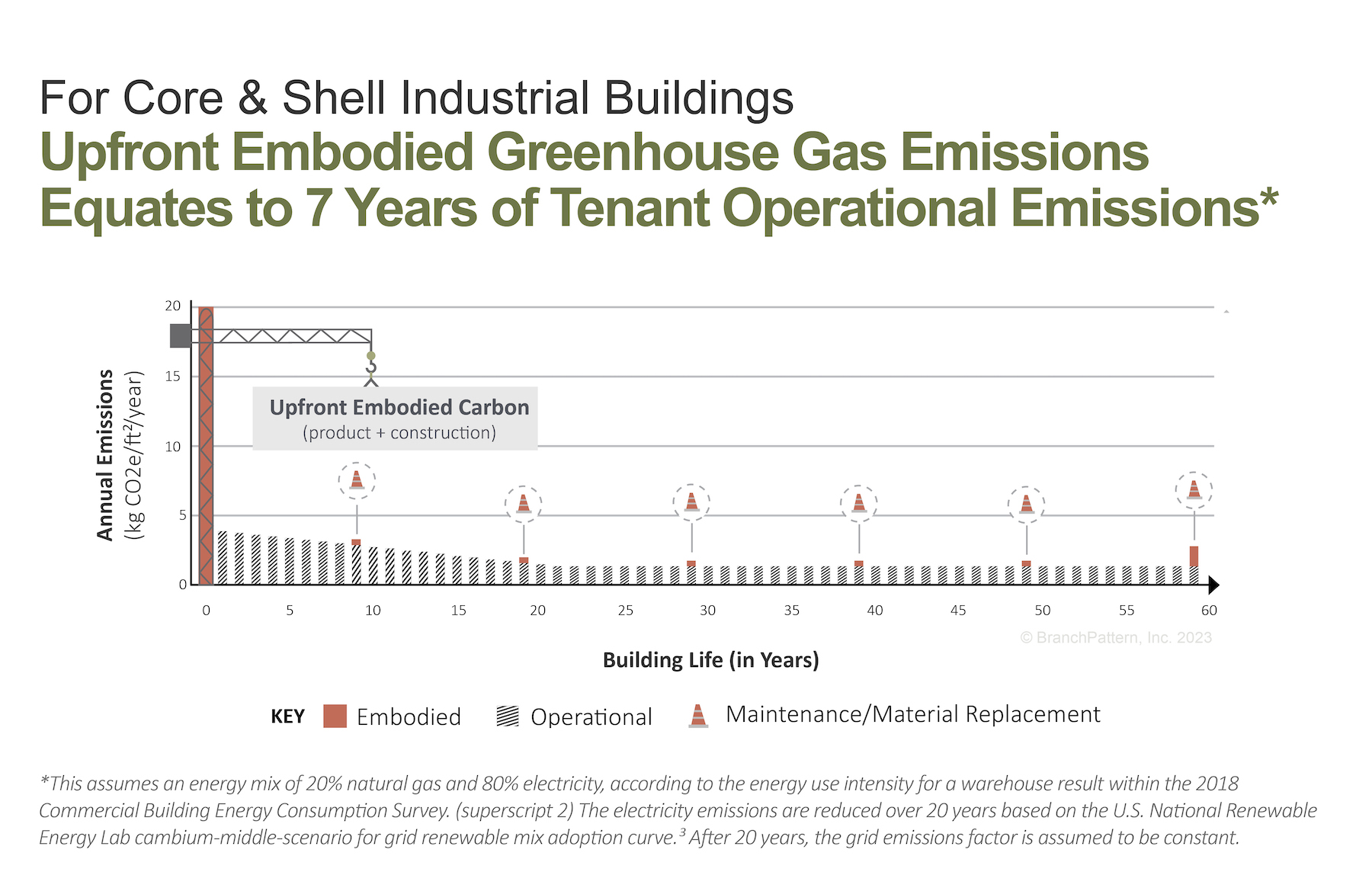
Stakeholders within an industrial building project have varying responsibilities and financial interests in reducing EC in their buildings. The developer, for example, makes decisions about building materials and design. The tenant, on the other hand, might participate in improvements that include MEP systems and interior finishes.
A small but telling sample
In 2022, BranchPattern conducted 46 lifecycle assessments, of which 26 for nine separate real estate developers or owners in six geographic regions of the U.S. are included in its report. The analyses were confined to Class A core and shell industrial warehouses of similar scope. The reference period for the lifetimes of the buildings was 60 years.
BranchPattern compared its EC intensity finding with a 2017 Carbon Benchmark Study of two buildings whose average EC intensity was 20.2 kg per sf.
The report concedes that its own sample isn’t large enough from which to draw definitive conclusions. “A larger, more robust dataset is required to determine regional variation with statistical significance,” the report states. That being said, BranchPattern’s study shows “a strong, positive, linear correlation” between a building’s size and its EC emissions.
The report finds that, on average, 55% of an industrial warehouse’s EC comes from its structure and enclosure, such as slab-on-grade, exterior walls, framing, and roofdeck. Consequently, an optimal EC reduction strategy addresses emissions from building materials like concrete and steel, which alone account for 11% and 10%, respectively, of global greenhouse gas emissions. For example, cement accounts for about 80% of the carbon emissions from a traditional concrete mix. Switching that mix from 100% ordinary Portland Cement to 50% fly ash/slag cement could reduce the mix’s carbon footprint by approximately 40%.
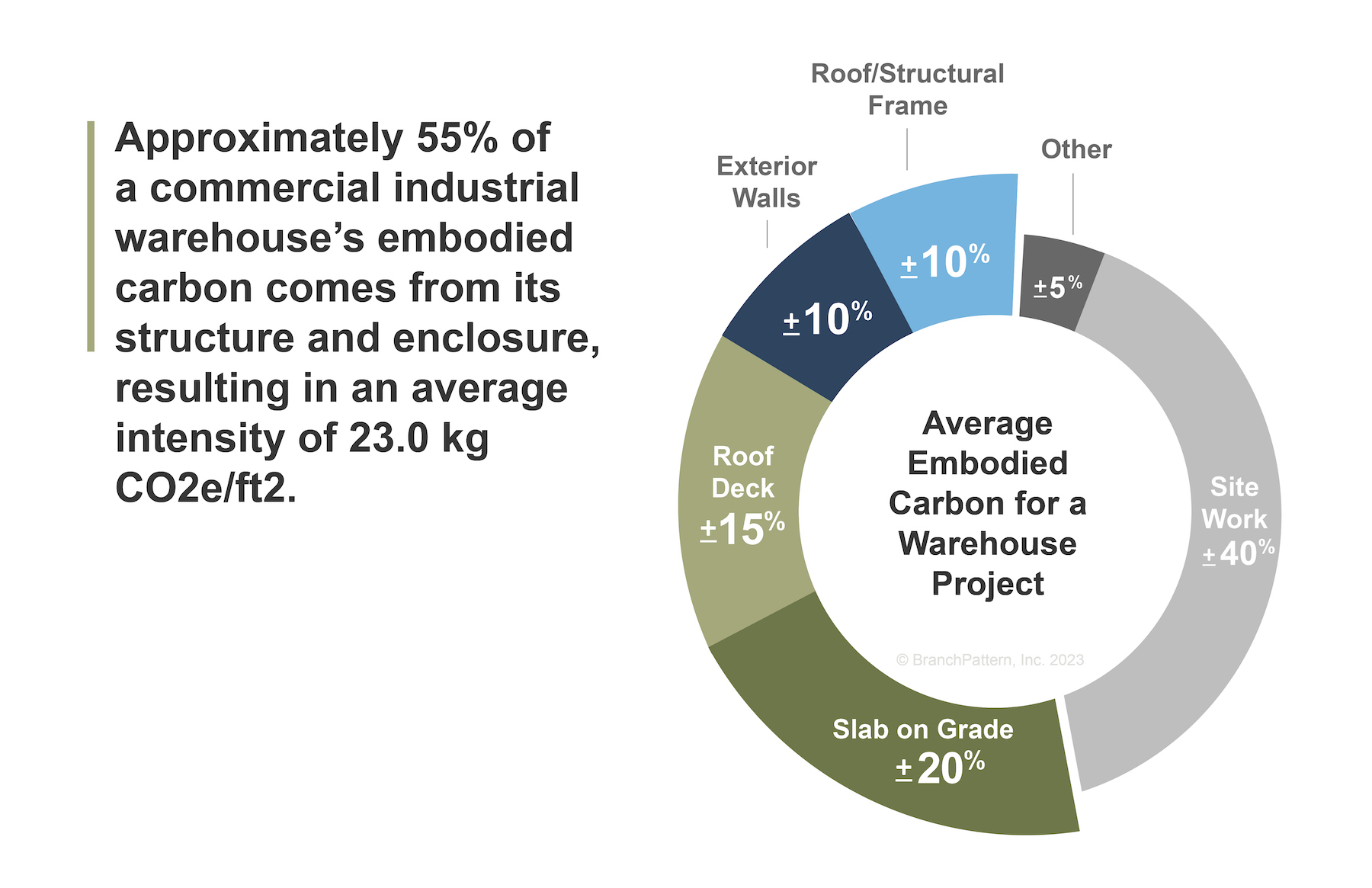
Buildings might also be designed to reduce their overall concrete volume via alternate wall assemblies or insulated metal panels. BranchPattern’s report estimates that substituting mass timber for steel or concrete assemblies would reduce the carbon footprint from the building’s structure/enclosure by 50%. (Affinius Capital recently completed a 161,200-sf Class A warehouse with mass timber, resulting in a 60% reduction in EC compared to a concrete build.) Even using Electric Arc Furnace-produced steel instead of basic oxygen furnace-produced steel cuts EC emissions by 40% to 60%.
Electric Arc Furnace steel is more likely to have a higher recycled content. Recycled materials in general typically have lower EC than virgin materials. However, the report observes that conventional demolition is still cheaper than recovering materials, especially wood. “A building designed for disassembly may have greater residual value, as the integrity of more materials is preserved.”
A call to action
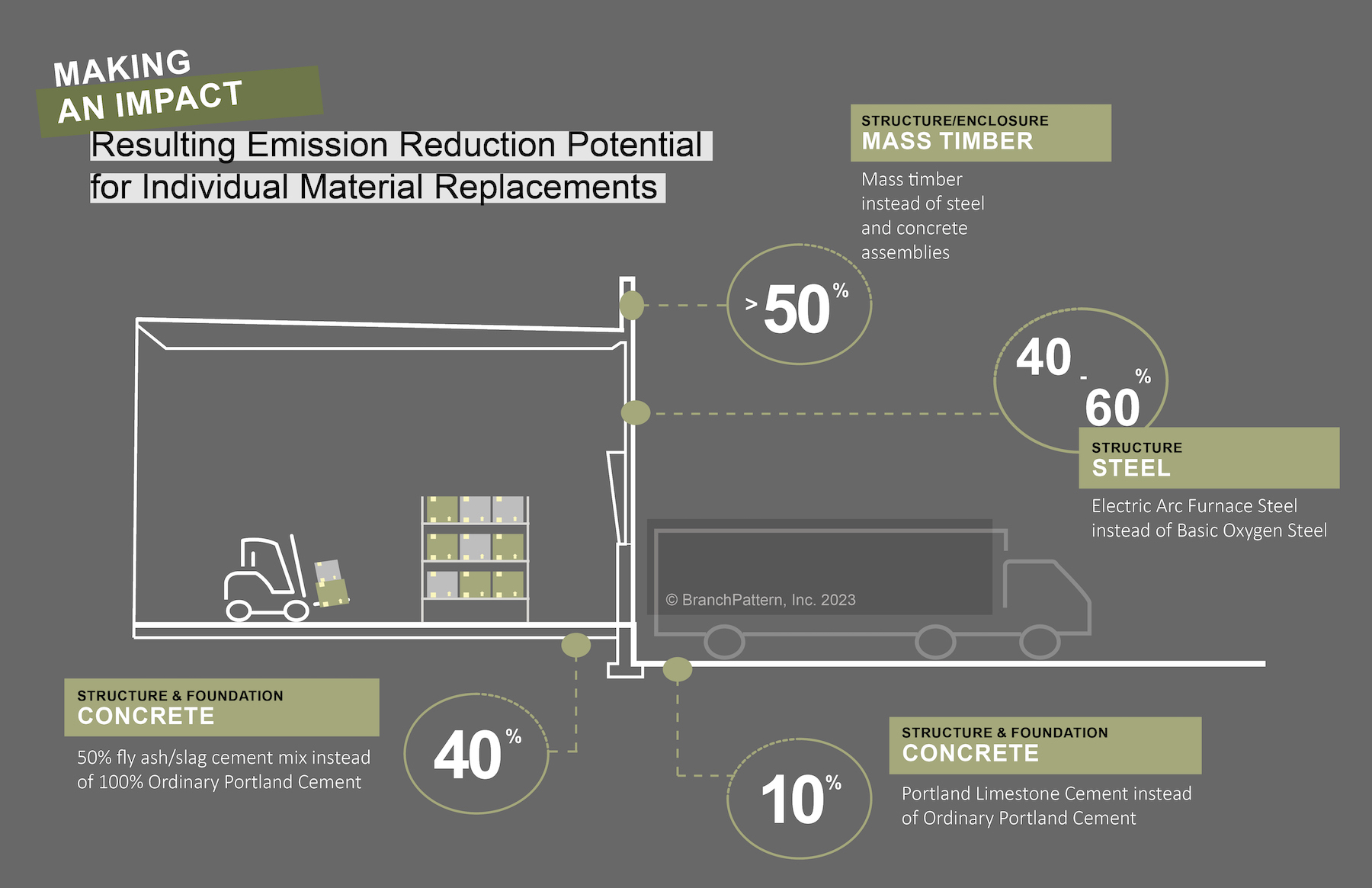
The Paris Climate Accords have set a goal of reducing greenhouse gas emissions 40% by 2030, compared to 1990 emissions. To achieve that goal, “we must now focus on embodied carbon,” the BranchPattern report states. That will require transparent and clear carbon accounting methods that support stakeholder engagement. “To reduce, we must measure,” asserts the report.
Government funding and policy changes are increasing the development and implementation of low-carbon construction solutions. Green building certification programs “will continue to play a significant role mainstreaming embodied carbon knowledge within various building sectors,” the report predicts. The availability of lower-carbon materials will increase and be cost competitive. Engineering solutions in areas like carbon capture, utilization and storage will advance.
“Embodied carbon related emission reductions are possible, necessary, and promising,” the report concludes.
Related Stories
Industrial Facilities | Sep 6, 2023
Georgia-Pacific pushes forward on construction of newest industrial building in Tennessee
The 900,000-sf manufacturing/warehousing facility will support the company’s disposable tableware brands when it opens next year.
Giants 400 | Aug 22, 2023
Top 115 Architecture Engineering Firms for 2023
Stantec, HDR, Page, HOK, and Arcadis North America top the rankings of the nation's largest architecture engineering (AE) firms for nonresidential building and multifamily housing work, as reported in Building Design+Construction's 2023 Giants 400 Report.
Giants 400 | Aug 22, 2023
2023 Giants 400 Report: Ranking the nation's largest architecture, engineering, and construction firms
A record 552 AEC firms submitted data for BD+C's 2023 Giants 400 Report. The final report includes 137 rankings across 25 building sectors and specialty categories.
Giants 400 | Aug 22, 2023
Top 175 Architecture Firms for 2023
Gensler, HKS, Perkins&Will, Corgan, and Perkins Eastman top the rankings of the nation's largest architecture firms for nonresidential building and multifamily housing work, as reported in Building Design+Construction's 2023 Giants 400 Report.
Industrial Facilities | Aug 22, 2023
Rising battery demand charges industrial plant construction
Several U.S. factories are being built in partnership with automakers.
Industrial Facilities | Aug 3, 2023
The state of battery manufacturing in the era of EV
One of the most significant changes seen in today’s battery plant is the full manufacturing process—from raw materials to the fully operational battery.
Market Data | Aug 1, 2023
Nonresidential construction spending increases slightly in June
National nonresidential construction spending increased 0.1% in June, according to an Associated Builders and Contractors analysis of data published today by the U.S. Census Bureau. Spending is up 18% over the past 12 months. On a seasonally adjusted annualized basis, nonresidential spending totaled $1.07 trillion in June.
Digital Twin | Jul 31, 2023
Creating the foundation for a Digital Twin
Aligning the BIM model with the owner’s asset management system is the crucial first step in creating a Digital Twin. By following these guidelines, organizations can harness the power of Digital Twins to optimize facility management, maintenance planning, and decision-making throughout the building’s lifecycle.
Market Data | Jul 24, 2023
Leading economists call for 2% increase in building construction spending in 2024
Following a 19.7% surge in spending for commercial, institutional, and industrial buildings in 2023, leading construction industry economists expect spending growth to come back to earth in 2024, according to the July 2023 AIA Consensus Construction Forecast Panel.
Standards | Jun 26, 2023
New Wi-Fi standard boosts indoor navigation, tracking accuracy in buildings
The recently released Wi-Fi standard, IEEE 802.11az enables more refined and accurate indoor location capabilities. As technology manufacturers incorporate the new standard in various devices, it will enable buildings, including malls, arenas, and stadiums, to provide new wayfinding and tracking features.


